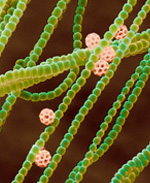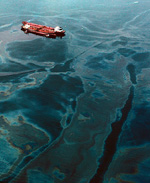- How the sea serves us
- > Many of the ecosystem services provided by the sea are threatened today by overexploitation, environmental pollution and greenhouse gases. Yet in many cases, how severely individual habitats are degraded and ecosystem services are impaired is just not known. Researchers are therefore attempting to assess the exact condition of marine ecosystems. Such analysis is important in order to plan concrete protection measures and to define critical limits and target values.

Marine ecosystem services at risk
The sea is of fundamental importance to humankind due to the many ecosystem services it provides. To gain a clearer analytical framework for the vast array of these services, marine experts have divided them into four classes. The defined categories are: provi-sioning services, supporting services, regulating services and cultural services. Provisioning services include, in particular, the production of marine fish for human consumption. Cultural services comprise, amongst others, tourism and traditions connected to the sea, such as artisan boat-building. Supporting services include first and foremost primary productivity, i.e. the generation of biomass by phytoplankton by means of photosynthesis. Finally, regulating services are taken by scientists to include fundamental biological, chemical and physical processes in the oceans, such as nitrogen and carbon cycles as well ocean currents which affect the terrestrial climate amongst other things. The elimination of marine pollutants is another regulating service offered by marine ecosystems. Many of these services are now under threat from human overexploitation, environmental pollu-tion or greenhouse gas emissions. Carbon dioxide emissions in particular pose a global threat to the oceans today. Firstly, these emissions are causing the oceans to warm as a result of the greenhouse effect. Secondly, a significant proportion of atmospheric carbon dioxide becomes dissolved in seawater, slowly acidifying the oceans. Coastal regions, many of which are extremely densely settled, are under particular pressure from environmental problems. The United Nations estimate that today more than 40 per cent of the world’s population, i.e. more than 2.8 billion people, live within 100 kilometres of the coast. Thirteen of the world’s 20 megacities home to 10 million or more people lie along coasts. Many coastal regions are subject to intense land use, and in turn also to intense degradation. Eutrophication of coastal seas due to nutrients from agricultural sources is a major problem. It results in strong algal growth, and as the algae decay oxygen depletion in the water ensues. The direct destruction of inshore habitats also continues to this day, affecting wetlands, saltmarshes and mudflats, coral reefs and mangrove forests. They mostly fall victim to construction projects, coastal impounding and pollutant discharge. In order to establish a pathway towards sustain-able use of marine ecosystems, scientists are now attempting to determine firstly the state of these ecosystems. To take well-targeted improvement action, it is essential to have detailed knowledge of the degree to which an ecosystem has been impaired or in how far its status still resembles the original “good status”. To this end, U.S. scientists have developed the global Ocean Health Index which allows for comparisons of the status of different marine ecosystems. The Index captures environmental aspects such as species diversity, while also extending to social aspects such as the status of coastal economies. But this is not sufficient for targeted environmental policy measures. Concrete measurements and limit values are needed to ensure sufficient reductions in nutrient inputs. In Europe, environmental indicators and targeted values are currently being defined as part of the Marine Strategy Framework Directive. The aim of the Directive is to once again achieve a good environmental status across Europe’s marine environment. To this end, all pressure indicators are assigned clear limit values which serve to provide political direction.

